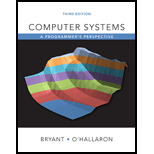
Concept explainers
A)
Given Information:
The given code is:
// define structure
square point_color
{
// variable declaration
int c;
int m;
int y;
int k;
};
// declare structure array
struct point_color square[16][16];
int i,j;
// traverse through the array
for(i=0;i<16;i++)
{
//traverse through elements
for(j=0;j<16;j++)
{
//square all elements of the 2-D array
square[j][i].c=0;
square[j][i].m=0;
square[j][i].y=1;
square[j][i].k=0;
}
}
Write hit:
If the information in the cache is reserved or in dirty state then the cache line is updated in its place without updating memory set from its state to dirty.
- If the state of information is in valid state then it executes a write-through operation.
- It then updates the memory and block and changes its blocked state to reserved state.
Write miss:
A partial cache line write is handed as a read miss followed by a write hit. All the other caches are left in the invalid state and the reserved state is occupied by the current state.
B)
Given Information:
The given code is:
// define structure
square point_color
{
// variable declaration
int c;
int m;
int y;
int k;
};
// declare structure array
struct point_color square[16][16];
int i,j;
// traverse through the array
for(i=0;i<16;i++)
{
//traverse through elements
for(j=0;j<16;j++)
{
//square all elements of the 2-D array
square[j][i].c=0;
square[j][i].m=0;
square[j][i].y=1;
square[j][i].k=0;
}
}
Write hit:
If the information in the cache is reserved or in dirty state then the cache line is updated in its place without updating memory set from its state to dirty.
- If the state of information is in valid state then it executes a write-through operation.
- It then updates the memory and block and changes its blocked state to reserved state.
Write miss:
A partial cache line write is handed as a read miss followed by a write hit. All the other caches are left in the invalid state and the reserved state is occupied by the current state.
C)
Given Information:
The given code is:
//define structure
square point_color
{
// variable declaration
int c;
int m;
int y;
int k;
};
// declare structure array
struct point_color square[16][16];
int i,j;
// traverse through the array
for(i=0;i<16;i++)
{
//traverse through elements
for(j=0;j<16;j++)
{
//square all elements of the 2-D array
square[j][i].c=0;
square[j][i].m=0;
square[j][i].y=1;
square[j][i].k=0;
}
}
Want to see the full answer?
Check out a sample textbook solution
Chapter 6 Solutions
Computer Systems: A Programmer's Perspective (3rd Edition)
- Describe three (3) Multiplexing techniques common for fiber optic linksarrow_forwardCould you help me to know features of the following concepts: - commercial CA - memory integrity - WMI filterarrow_forwardBriefly describe the issues involved in using ATM technology in Local Area Networksarrow_forward
- For this question you will perform two levels of quicksort on an array containing these numbers: 59 41 61 73 43 57 50 13 96 88 42 77 27 95 32 89 In the first blank, enter the array contents after the top level partition. In the second blank, enter the array contents after one more partition of the left-hand subarray resulting from the first partition. In the third blank, enter the array contents after one more partition of the right-hand subarray resulting from the first partition. Print the numbers with a single space between them. Use the algorithm we covered in class, in which the first element of the subarray is the partition value. Question 1 options: Blank # 1 Blank # 2 Blank # 3arrow_forward1. Transform the E-R diagram into a set of relations. Country_of Agent ID Agent H Holds Is_Reponsible_for Consignment Number $ Value May Contain Consignment Transports Container Destination Ф R Goes Off Container Number Size Vessel Voyage Registry Vessel ID Voyage_ID Tonnagearrow_forwardI want to solve 13.2 using matlab please helparrow_forward
- a) Show a possible trace of the OSPF algorithm for computing the routing table in Router 2 forthis network.b) Show the messages used by RIP to compute routing tables.arrow_forwardusing r language to answer question 4 Question 4: Obtain a 95% standard normal bootstrap confidence interval, a 95% basic bootstrap confidence interval, and a percentile confidence interval for the ρb12 in Question 3.arrow_forwardusing r language to answer question 4. Question 4: Obtain a 95% standard normal bootstrap confidence interval, a 95% basic bootstrap confidence interval, and a percentile confidence interval for the ρb12 in Question 3.arrow_forward
 Systems ArchitectureComputer ScienceISBN:9781305080195Author:Stephen D. BurdPublisher:Cengage Learning
Systems ArchitectureComputer ScienceISBN:9781305080195Author:Stephen D. BurdPublisher:Cengage Learning Microsoft Visual C#Computer ScienceISBN:9781337102100Author:Joyce, Farrell.Publisher:Cengage Learning,
Microsoft Visual C#Computer ScienceISBN:9781337102100Author:Joyce, Farrell.Publisher:Cengage Learning, C++ for Engineers and ScientistsComputer ScienceISBN:9781133187844Author:Bronson, Gary J.Publisher:Course Technology Ptr
C++ for Engineers and ScientistsComputer ScienceISBN:9781133187844Author:Bronson, Gary J.Publisher:Course Technology Ptr C++ Programming: From Problem Analysis to Program...Computer ScienceISBN:9781337102087Author:D. S. MalikPublisher:Cengage Learning
C++ Programming: From Problem Analysis to Program...Computer ScienceISBN:9781337102087Author:D. S. MalikPublisher:Cengage Learning Operations Research : Applications and AlgorithmsComputer ScienceISBN:9780534380588Author:Wayne L. WinstonPublisher:Brooks Cole
Operations Research : Applications and AlgorithmsComputer ScienceISBN:9780534380588Author:Wayne L. WinstonPublisher:Brooks Cole EBK JAVA PROGRAMMINGComputer ScienceISBN:9781337671385Author:FARRELLPublisher:CENGAGE LEARNING - CONSIGNMENT
EBK JAVA PROGRAMMINGComputer ScienceISBN:9781337671385Author:FARRELLPublisher:CENGAGE LEARNING - CONSIGNMENT





